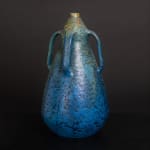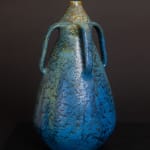Teplitz Fachschule Austrian, 1897-1910
c. 1905
Further images
Flux- continuous moving, a glazing method, fusion- the artist who produced this remarkable vase has presented a profoundly poetic and technical meditation on this subject. Moving way beyond the pursuit of creating only functional objects, the student ceramists at Fachschule Teplitz had ingrained in them the Europeans’ fascination for Japanese objects “from the floating world” and the design aesthetic known as Japonisme. Truly modern interpretations of Japonisme had begun to evolve into an internalizing of the aesthetic principles and a shift away from imitation of Japanese style applied to a Western format. This vase is noteworthy in that it illustrates this important Modernist shift in European ceramics. The elements of the saki bottle can be divided into three key components which taken as a whole create a rather feminine line. In keeping with this approach, the Fachschule student presents a slender bare neck, like décolletage, which flares ever slightly and then narrows to a high waist before voluptuously widening down and terminating gracefully to a round base. The ceramist gives special emphasis to pleasing proportions and the complementary relationship to the number 3; the measurement at the widest section of the vase equals the same distance from that point up to where the bottoms of the handles join to the body of the vase as well as the full arms’ length. Instead of inscribing the vase with Japanese calligraphy denoting a saki shop, the student takes a radically modern approach by attaching the vase with four handles. And yet, this act is every bit a form of written identification. The arms are the embodiment of the idea of flux in that they are a substance applied to a surface by the welding together to promote their union. The handles serve a new and surprising function. They are carriers of a concept. Fluidity- flux -can be created when an artist joins disparate elements into a harmonious whole.
Flux is also a substance used to promote the fusion of minerals and metals and a term describing ceramic glazing. The presence of silica in glazes creates a glassy finish when fired at high temperatures. Matte glazes result from the presence of crystals under the surface and the balance between silica, flux and alumina in the glaze materials. By deliberately under-firing this vase and playing with a combination of additives forming the flux glaze, the end result appears matte and textured. The orange peel quality and alluring color palette are transformative. The effect evokes a waterfall or another continuous moving flow of water like a stream - in flux.
So not only does this artist take a Meiji Period saki bottle and the aesthetic tenets of Japonisme as the formal and theoretical points of departure, the artist infuses the work with the symbolism of skill itself where artistic mastery as the embodiment of flux becomes the subject to ponder. As a fully realized and beautifully rendered piece, the vase attests to the artistic prowess of its creator. No longer a mere student working in the shadows of the teacher and no longer simply imitating or replicating past styles, this emerging artist shows the complete fluid transfer from student to master ceramist. Seen in this light, the vase represents a significant and pivotal achievement in Modern European ceramic ware.











